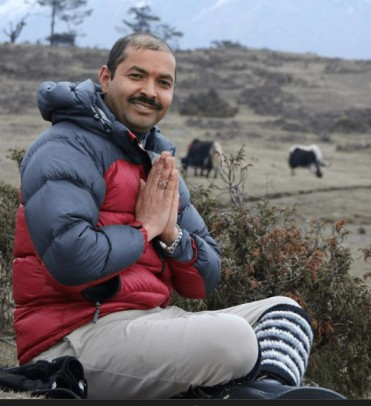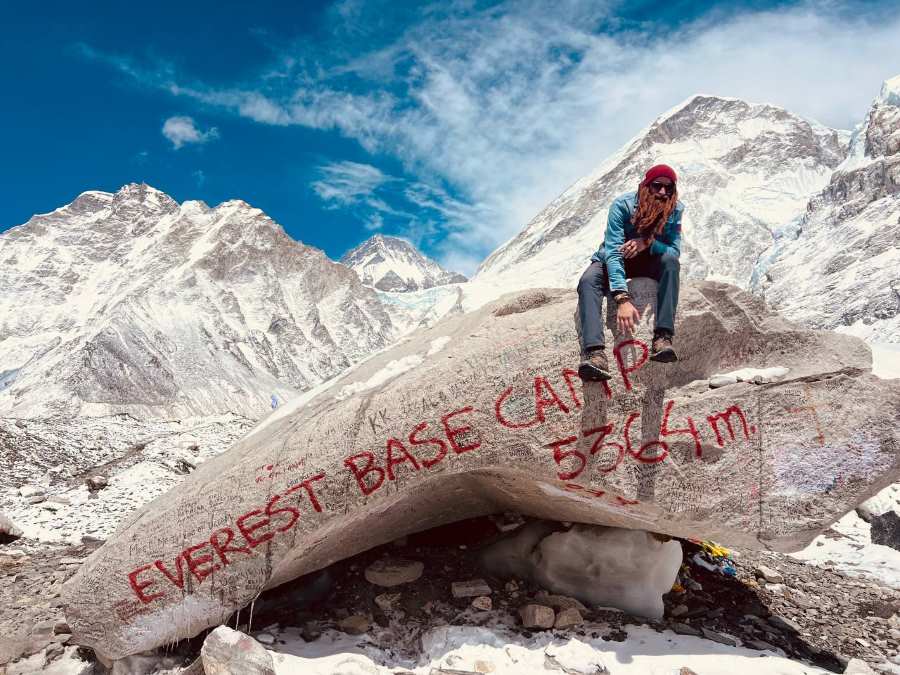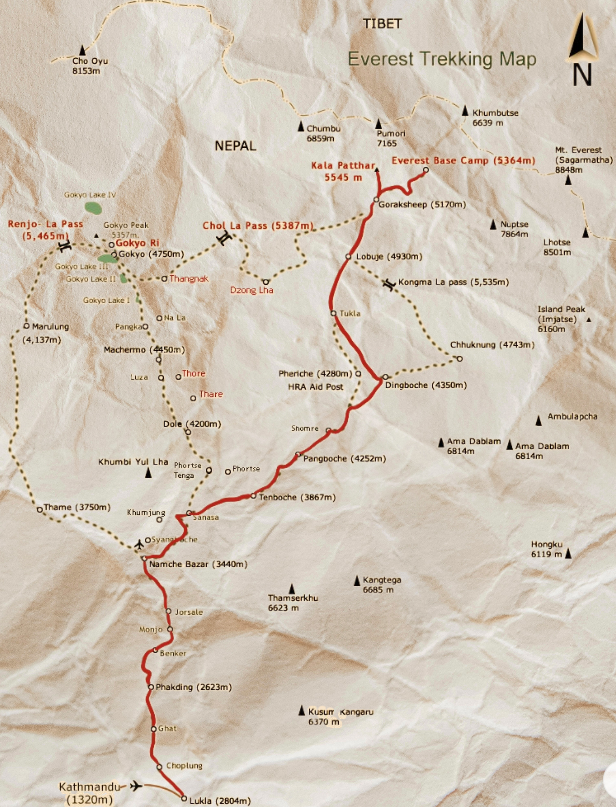At a Glance
15 D
Challenging
2-18
Air-conditioned private tourist vehicle.
Trekking
Mar,Apr ,May / Sept,oct,Nov
Shared accommodation at guest house .
Overview
The Everest Base Camp Trek is a popular trekking route that takes travelers through the stunning landscape of the Himalayas in Nepal. It is a physically challenging trek that requires a good level of fitness, but it is also a rewarding experience for those who are up for the challenge.
The trek starts in Lukla, a small mountain village in the Solu-Khumbu region of Nepal, and follows the Dudh Kosi River through the Sagarmatha National Park. Along the way, trekkers will pass through a number of small villages, including Namche Bazaar, which is the gateway to the Khumbu region and home to the famous Sherpa people. As trekkers make their way up the mountain, they will have the opportunity to see some of the most iconic peaks in the world, including Mt. Everest (8848.86m), Lhotse (8516m), Nuptse (7861m), and Ama Dablam (6812m). The trek also offers breathtaking views of the surrounding mountains and valleys, as well as the opportunity to see wildlife such as Himalayan yaks, mountain goats, and snow leopards.
The culture and religion of the local people are an integral part of this trek. Trekkers will have the opportunity to visit monasteries and temples along the way and will be able to learn about the traditional way of life of the Sherpa people. The trek also offers the opportunity to visit the famous Tengboche Monastery, which is the spiritual center of the Khumbu region and home to a number of important religious artifacts.
This Trek is a once-in-a-lifetime opportunity to experience the beauty of the Himalayas and the rich culture of Nepal. It is a physically demanding trek, but the rewards of reaching the base camp of the world's highest mountain and experiencing the traditional way of life of the Sherpa people make it a truly unforgettable experience.
Important Note:
It is important to be physically fit and well-prepared for the trek, as the journey to the base camp of Mt. Everest is challenging and requires a good level of physical fitness. You should also be aware of the risks and challenges associated with high-altitude trekking and should take necessary precautions to prevent altitude sickness.
It is also important to respect the local culture and customs of Nepal and to be mindful of the environmental impact of the trek. You should take care to leave no trace and to follow the Leave No Trace principles to minimize their impact on the environment. So, these are some of the things that you should keep in mind while planning and embarking on this trek.
Itinerary
Day 1
On the first day of the Everest Base Camp Trek, you will arrive in Kathmandu, the capital city of Nepal. After arriving at the airport, you will be transferred to their hotel in the city. You can then relax and rest after their long journey and get ready for the exciting days ahead. Overnight stay in Hotel.
Day 2
On the second day of the Everest Base Camp Trek, you will have the opportunity to explore Kathmandu and learn more about the city's culture and history. This day is usually dedicated to a city tour, during which you will visit some of the most popular sights and attractions in the city.
One of the highlights of the city tour is Durbar Square, which is home to the royal palace and a number of ancient temples. Visitors can explore the palace and visit the many temples that are located within the complex, including the Kumari Temple, which is home to the living goddess of Nepal.
Another must-see attraction in Kathmandu is the Swayambhunath Temple, which is a popular Buddhist shrine located on a hill overlooking the city. The temple is a UNESCO World Heritage Site and is home to a number of important Buddhist artifacts. You can climb to the top of the hill and take in the stunning views of the city and the surrounding mountains.
The Boudhanath Stupa is another important religious site that is worth visiting. This large Buddhist stupa is located on the outskirts of Kathmandu and is a popular destination for both locals and tourists. Visitors can walk around the stupa and learn about the importance of Buddhism in Nepal.
Day 3
On the third day of the Everest Base Camp Trek, you will start your journey toward the base camp of Mt. Everest. The day begins with a flight from Kathmandu to Lukla, which is a small mountain village located in the Solu-Khumbu region of Nepal. The flight is a short but spectacular journey, offering breathtaking views of the Himalayan Mountains.
Upon arrival in Lukla, you will begin your trek towards Phakding, which is a small village located along the Dudh Kosi river. The trek is relatively easy and takes about 4-5 hours to complete. Along the way, you will pass through a number of small villages and will have the opportunity to see the local way of life.
Phakding is a small village located at an altitude of 2610 meters, and it is the perfect place to rest and acclimatize to the high altitude. The village is home to a number of small guesthouses and lodges, where you can spend the night and enjoy a warm meal.
Day 4
On the fourth day of the Everest Base Camp Trek, you will continue your journey toward the base camp of Mt. Everest. The trek starts with a short walk from Phakding to Monjo, which is a small village located along the Dudh Kosi River. From Monjo, the trail begins to climb steadily, passing through a number of small villages and forests. After about 4-5 hours of trekking, travelers will reach Namche Bazaar, which is the gateway to the Khumbu region and the home of the famous Sherpa people. Namche Bazaar is a bustling town that is known for its vibrant markets, colorful houses, and traditional culture.
Namche Bazaar is located at an altitude of 3440 meters, and it is the perfect place to rest and acclimatize to the high altitude. The town is home to a number of small guesthouses and lodges, where you can spend the night and enjoy a warm meal. Namche Bazaar is also home to a number of important attractions, including the Sagarmatha National Park Visitor Center and the Namche Monastery, which is a popular destination for those interested in learning about the local culture and religion.
Day 5
On the fifth day of the Everest Base Camp Trek, you will have a chance to rest and acclimatize to the high altitude in Namche Bazaar. This is an important day as it allows you to get used to the thin air and help prevent altitude sickness.
There are a number of activities that travelers can do on their acclimatization day in Namche Bazaar. One option is to visit the Sagarmatha National Park Visitor Center, which is located in the town and offers information about the local flora and fauna, as well as the history of the region.
Another option is to visit the Namche Monastery, which is a popular destination for those interested in learning about the local culture and religion. The monastery is home to a number of important religious artifacts, and you can take a guided tour to learn more about the history and significance of the site.
You can also take a short hike to the Everest View Hotel, which offers breathtaking views of the surrounding mountains and valleys. This is a great way to get some exercise and take in the stunning landscape of the Himalayas.
Day 6
On the sixth day of the Everest Base Camp Trek, you will continue your journey toward the base camp of Mt. Everest. The trek starts with a descent from Namche Bazaar to the Dudh Kosi River and then follows the river through a series of small villages and forests.
After about 4-5 hours of trekking, you will reach Tengboche, which is a small village located at an altitude of 3860 meters. Tengboche is home to the Tengboche Monastery, which is the spiritual center of the Khumbu region and a popular destination for travelers interested in learning about the local culture and religion.
The Tengboche Monastery is home to a number of important religious artifacts, including a large statue of the Buddha and a number of ancient texts. Tengboche is a beautiful village located in a stunning location, with breathtaking views of the surrounding mountains and valleys. It is the perfect place to rest and acclimatize to the high altitude before continuing your journey towards the base camp of Mt. Everest.
Day 7
On the seventh day of the Everest Base Camp Trek, you will continue your journey toward the base camp of Mt. Everest. The trek starts with a descent from Tengboche to the Imja Khola River and then follows the river through a series of small villages and forests.
After about 4-5 hours of trekking, you will reach Dingboche, which is a small village located at an altitude of 4360 meters. Dingboche is a beautiful village located in a stunning location, with breathtaking views of the surrounding mountains and valleys. It is the perfect place to rest and acclimatize to the high altitude before continuing your journey towards the base camp of Mt. Everest.
Dingboche is home to a number of small guesthouses and lodges, where travelers can spend the night and enjoy a warm meal. The village is also home to a number of small shops and restaurants, where travelers can buy supplies or try some of the local cuisines.
Dingboche is a popular stop for travelers on the Everest Base Camp Trek, and it is a great place to learn about the local culture and way of life. There are many interesting sights and attractions to see in the village, including the Dingboche Monastery and the Dingboche Stupa, which are popular destinations for travelers interested in learning about the local culture and religion.
Day 8
On the eighth day of the Everest Base Camp Trek, you will have a chance to rest and acclimatize to the high altitude in Dingboche. This is an important day as it allows you to get used to the thin air and help prevent altitude sickness.
There are a number of activities that travelers can do on their acclimatization day in Dingboche. One option is to visit the Dingboche Monastery, which is located in the village and is home to a number of important religious artifacts.
Another option is to take a short hike to the nearby viewpoint, which offers breathtaking views of the surrounding mountains and valleys. This is a great way to get some exercise and take in the stunning landscape of the Himalayas.
You can also visit the Dingboche Stupa, which is a popular destination for travelers interested in learning about the local culture and religion. The stupa is located on a hill overlooking the village and offers stunning views of the surrounding mountains and valleys. Dingboche is a peaceful and tranquil place, and it is the perfect place to relax and recharge before continuing the journey toward the base camp of Mt. Everest.
Day 9
On the ninth day of the Everest Base Camp Trek, you will continue your journey toward the base camp of Mt. Everest. The trek starts with a climb from Dingboche to the Dingboche Pass, which is a popular stop for travelers on the trek. The pass offers stunning views of the surrounding mountains and valleys, and it is a great place to take a break and enjoy the scenery.
After crossing the Dingboche Pass, the trail continues to climb steadily, passing through a series of small villages (Thukla). After about 4-5 hours of trekking, you will reach Lobuche, which is a small village located at an altitude of 4910 meters.
Lobuche is a beautiful village located in a stunning location, with breathtaking views of the surrounding mountains and valleys. It is the perfect place for travelers to rest and acclimatize to the high altitude before continuing their journey towards the base camp of Mt. Everest.
In the evening, you can relax and unwind in their guesthouse, and enjoy some of the local cuisine and a warm cup of tea. Lobuche is a peaceful and tranquil place, and it is the perfect place to relax and recharge before continuing the journey toward the base camp of Mt. Everest.
Day 10
On the tenth day of the Everest Base Camp Trek, you will continue your journey toward the base camp of Mt. Everest. The trek starts with a climb from Lobuche to Gorak Shep, which is a small village located at an altitude of 5170 meters. Gorak Shep is the last village before the base camp of Mt. Everest, and it is the perfect place to rest and acclimatize to the high altitude before continuing your journey.
After reaching Gorak Shep, you will have the opportunity to visit the base camp of Mt. Everest, which is located at an altitude of 5364 meters. The base camp is the starting point for all expeditions to the summit of Mt. Everest, and it is a popular destination for travelers interested in mountain climbing and the history of the region.
The base camp is in a stunning location, with breathtaking views of the surrounding mountains and valleys. After visiting the base camp, you can return to Gorak Shep and spend the night in a guesthouse or lodge. The village is home to a number of small guesthouses and lodges, where you can enjoy a warm meal and get some rest before continuing your journey the next day.
Day 11
On the eleventh day of the Everest Base Camp Trek, you will have the opportunity to hike to Kala Patthar, which is a popular viewpoint located near the base camp of Mt. Everest. The hike to Kala Patthar is a challenging but rewarding experience, as it offers breathtaking views of the surrounding mountains and valleys. Kala Patthar is located at an altitude of 5545 meters, and it is the highest point on the trek. From Kala Patthar, you can see some of the most iconic peaks in the world, including Mt. Everest, Lhotse, Nuptse, and Ama Dablam.
After reaching Kala Patthar, you will return to Gorak Shep and will continue your journey towards Pheriche, which is a small village located at an altitude of 4280 meters. Pheriche is a beautiful village located in a stunning location, with breathtaking views of the surrounding mountains and valleys. It is the perfect place for travelers to rest and acclimatize to the high altitude before continuing their journey towards Namche Bazaar.
Day 12
On the twelfth day of the Everest Base Camp Trek, you will continue your journey towards Namche Bazaar. The trek starts with a descent from Pheriche to the Dudh Kosi River and then follows the river through a series of small villages and forests.
After about 4-5 hours of trekking, you will reach Namche Bazaar, which is a bustling town located at an altitude of 3440 meters. Namche Bazaar is a peaceful and tranquil place.
Day 13
On the thirteenth day of the Everest Base Camp Trek, you will complete your journey and return to Lukla. The trek starts with a descent from Namche Bazaar to the Dudh Kosi River and then follows the river through a series of small villages and forests. After about 4-5 hours of trekking, travelers will reach Lukla, which is a small mountain village located at an altitude of 2840 meters.
Day 14
On the fourteenth day of the Everest Base Camp Trek, you will take a flight from Lukla to Kathmandu and return to the city. The flight is a short but spectacular journey, offering breathtaking views of the Himalayan Mountains.
Upon arrival in Kathmandu, you will be transferred to your hotel, where you can rest and relax after the trek. The hotel will be a welcome sight after spending two weeks in the mountains, and you can take a hot shower, unpack your bags, and get some much-needed rest.
Day 15
You will say goodbye to Nepal and depart from Kathmandu. This marks the end of their journey, and you can return home with unforgettable memories and a newfound appreciation for the beauty and culture of Nepal.
Faqs
The Everest Base Camp Trek typically takes about 14 days to complete, including travel time to and from Kathmandu. However, the actual duration of the trek may vary depending on the specific itinerary and the needs and preferences of the travelers.
The Everest Base Camp Trek is a challenging trek that requires a good level of physical fitness. The trek involves long days of hiking at high altitudes, and travelers should be prepared for the physical demands of the journey. However, the trek can be customized to suit the needs and abilities of travelers, and it is possible to find options that are less strenuous or more challenging.
The best time to do the Everest Base Camp Trek depends on personal preference and the specific needs and goals of the travelers. The trek can be done year-round, but the weather and conditions vary significantly depending on the season.
The peak tourist season for the Everest Base Camp Trek is from September to November, and this is when the weather is typically dry and clear, offering the best views of the surrounding mountains. However, this is also the busiest time of year, and travelers may experience more crowds and higher prices.
The shoulder season, from April to May and from December to January, is a good time to do the trek as the weather is generally good and the crowds are smaller. However, the weather can be more unpredictable and there is a higher risk of rain and snow.
The off-season, from June to August, is the least popular time to do the trek due to the monsoon season, which brings heavy rain and clouds. However, the prices are generally lower and the crowds are smaller during this time.
No, you do not need to be a skilled mountaineer to do the Everest Base Camp Trek. The trek is suitable for travelers of all abilities, and it can be customized to suit your needs and abilities. While the trek is challenging and requires a good level of physical fitness, it does not involve any technical climbing or mountaineering skills.
However, it is important to be physically fit and well-prepared for the trek, as the journey to the base camp of Mt. Everest is challenging and requires a good level of physical fitness. Travelers should also be aware of the risks and challenges associated with high-altitude trekking and should take necessary precautions to prevent altitude sickness.
Inclusion
- Arrival/departure airport transfers.
- 4* Hotel in Kathmandu with Breakfast.
- Teahouse accomodation during the tek / Standard level Guest house including meals (Breakfast, Lunch & Dinner) for 8 Nights.
- Kathmandu full day sightseeing in Monket Temple, Durbar Square, Boudhanath Stupa and Patan Durbar and its entrace fees.
- An English speaking guide for entire trekking and necessary porters.
- Lukla flight ticket and airport transfers from Kathmandu.
- Required trek entry permits for Everest Base Camp Trek with helicopter return.
- Gorakshep - Kathmandu helicopter return ride via Pheriche/Lukla group join basis (one helicopter can take one time from Gorakshep - Pheriche 2-3 pax at once and from Pheriche to Lukla 5 Person. In Lukla refueling and fly to Kathmandu.
- All applicable taxes.
Exclusion
- Lunch and dinner during your stay in Kathmandu.
- Personal expenses (Laundry, telephone calls, sweets, snacks, battery chargingetc.)
- All kind of beverages ( tea/coffee, coke, beer, bottled water, etc.)
- Travel Insurance (it is mandatory).
- Personal trekking equipment except stated above.
- Tipping to guide/porter.





